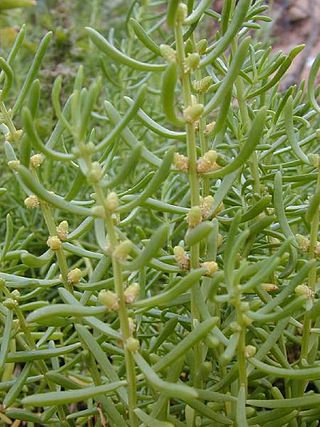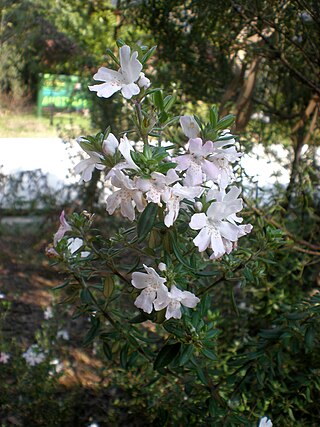
Dasiphora fruticosa is a species of hardy deciduous flowering shrub in the family Rosaceae, native to the cool temperate and subarctic regions of the northern hemisphere, often growing at high altitudes in mountains. Dasiphora fruticosa is still widely referenced in the horticultural literature under its synonym Potentilla fruticosa. Common names include shrubby cinquefoil, golden hardhack, bush cinquefoil, shrubby five-finger, widdy, kuril tea and tundra rose.

Batis is a genus of two species of flowering plants, the only genus in the family Bataceae. They are halophytic plants, native to the coastal salt marshes of warm temperate and tropical America and tropical Australasia.

Westringia is a genus of Australian shrubs. As with other members of the mint family their upper petal is divided into two lobes. There are four stamens - the upper two are fertile while the lower two are reduced to staminodes. The leaves are in whorls of 3 or 4.

Hemiandra pungens, commonly known as snakebush, is a shrub or trailing plant that is endemic to southwestern Western Australia.

Salvia fruticosa, or Greek sage, is a perennial herb or sub-shrub native to the eastern Mediterranean, including Southern Italy, the Canary Islands and North Africa. It is especially abundant in Palestine, Israel and Lebanon.

Prunus fruticosa, the European dwarf cherry, dwarf cherry, Mongolian cherry or steppe cherry is a deciduous, xerophytic, winter-hardy, cherry-bearing shrub. It is also called ground cherry and European ground cherry, but is not to be confused with plants in the distinct "Groundcherry" genus of Physalis.

The Brush Island is a continental island, contained within the Brush Island Nature Reserve, a protected nature reserve, known as Mit Island in the Dhurga language of the Murramamrang people of the Yuin nation see It is located off the south coast of New South Wales, Australia. The 47-hectare (120-acre) island and reserve is situated within the Tasman Sea, approximately 2 kilometres (1.2 mi) south-east of the coastal village of Bawley Point.
Westringia cremnophila, commonly known as Snowy River westringia, is a flowering plant in the family Lamiaceae, a rare shrub that is endemic to Victoria, Australia. It is a small shrub with leaves mostly in groups of three and white flowers.
Suaeda fruticosa is a species of flowering plant in the family Amaranthaceae. It is a small shrub, with very variable appearance over its wide range. It is a halophyte, and occurs in arid and semi-arid saltflats, salt marshes and similar habitats.

Westringia eremicola, commonly known as slender westringia or slender western rosemary, is a flowering plant in the family Lamiaceae and is endemic to eastern Australia. It is a small shrub, with narrow leaves and pink, mauve to white flowers.
Westringia viminalis is a flowering plant in the mint family. The specific epithet refers to its long, slender shoots. It is closely related to Westringia fruticosa, which is found on coastal heath and cliffs in New South Wales.

Lyonia fruticosa, the poor-grub or coastal plain staggerbush, is a plant species native to the US states of Florida, southern Georgia and the extreme southern part of South Carolina. It grows in pine woodlands and shrub bogs at elevations less than 100 meters.

Westringia dampieri, commonly known as shore westringia, is a flowering plant in the family Lamiaceae, it grows in South Australia and Western Australia. It is a small, dense shrub with white, mauve, cream or purple flowers.

Westringia longifolia, commonly known as long-leaved westringia, is a flowering plant in the family Lamiaceae and is endemic to southeastern Australia. It is a small shrub, with linear leaves and mostly white flowers.

Westringia davidii, also known as David's Westringia, is a species of plant in the mint family that is endemic to Australia.

Westringia blakeana is a flowering plant in the family Lamiaceae and grows in New South Wales and Queensland. It is a small shrub with mauve to whitish flowers with brown spots and leaves arranged in whorls.

Westringia rupicola is a species of plant in the mint family that is endemic to Australia.

Westringia rubiifolia, also known as sticky westringia, is a species of plant in the mint family that is endemic to the Australian state of Tasmania.

Westringia brevifolia Benth., commonly referred to as Greater Shortleaf Westringia is member of the Lamiaceae family, subfamily, Prosterantheroideae and one of four Westringia species native Tasmania, Australia. This evergreen shrub somewhat resembles rosemary and is similar in appearance to another Tasmanian species W. rigida, but can be distinguished by its shorter calyx lobes

Themeda grassland, or Themeda grassland on seacliffs and headlands, is an endangered tussock-grassland that is found on the immediate coast in southeastern Australia, which may also be an open shrubland or heathland with a grassy enclosure between shrubs.




















